Customizing Racquet Weight & Balance
Many of today’s touring pros play with customized racquets. Whether these players have their racquets customized during manufacturing (extra graphite reinforcement, weight, balance, handle shape, etc.) or after-market, they want racquets tailor-made for their needs.
There’s no reason why you can’t do the same. More and more, we’re finding non-professional players benefitting from this “tweaking” of their racquets to improve performance. From matching racquets to increasing overall weight, increasing torsional stability, raising the racquet’s sweetspot or counter-balancing a head-heavy racquet to make it head-light - all levels of players are finding benefit in customizing their racquets’ weight and balance.
In most cases customizing your racquet’s weight and balance is a reversible procedure - if you don’t like it, you can simply remove the lead tape that you added. This makes it possible to experiment with different amounts and placements of lead tape to find the “spec” that is just right for your game.
Tools You’ll Need
Postal Scale
Preferably one that reads in 1-2 gram increments for measuring racquets and lead tape. Model shown below is the Pelouze PE-5, available at Staples for $65. Other brands available include O-Haus and Sunbeam.

Balance Board
Viper Balance Board available at Tennis Warehouse for $27.99. You can also make your own balance board, using a dowel and yardstick.

Staple Gun
Necessary for re-installing butt cap if adding weight inside the handle. Arrow T-50 is acceptable for racquets with polyurethane foam handles and is available for about $20 through Home Depot. Racquets with graphite or composite handles require a more powerful staple gun. Sears’ Craftsman 9 Volt Staple Gun is $99 and will penetrate any handle type.
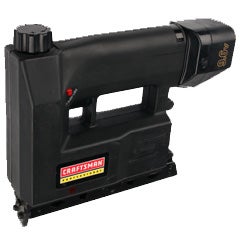
Hot Glue Gun
For attaching lead weights to inside of handle. About $15 through Home Depot.
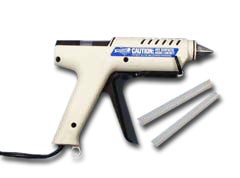
Lead Tape Techniques
Lead Tape Basics
Lead tape comes in 1/2 inch and 1/4 inch widths. 1 inch of 1/2 inch wide lead tape weighs .5 grams (1 inch of 1/4 inch lead tape weighs .25 grams). If adding small amounts of weight, it’s best to either cut the 1/2 inch tape in half (lengthwise) or use 1/4 inch tape. This width fits nicely between the existing grommets and the frame edge. If adding substantial weight inside the rim, it’s more convenient to remove the grommet strips and/or bumper, use 1/2 inch wide lead tape and punch holes with an awl to accomodate the grommets. If using this method, be sure to punch the holes from the opposite side and snip off the punched pieces of lead to avoid having them come loose inside the frame. Finish making the holes from the grommet side and replace the grommet/bumper.
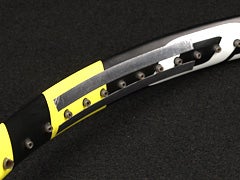
Applying Lead Tape
Keep lead tape strips short (no longer than 6 inches) to best achieve your objective. If necessary, you can add more layers to reach your weight objective. Pete Sampras’ racquet has 4-5 layers of lead tape at 3 and 9 o’clock.
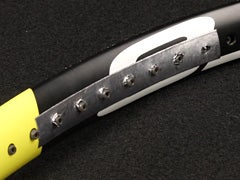
Why Add Weight?
The following are general guidelines for adding weight to meet certain objectives. Many players "mix & match", depending on their racquet's current specifications and what they're trying to achieve. Players with two or more of the same racquet can also match the weight and balance of each racquet by adding weight - see our Racquet Matching section below.
Torsional Stability
This is one of the most common reasons for adding weight to a frame. Placing weight at the sides (3 & 9 o’clock) not only makes the racquet heavier, but will help reduce frame twisting, or torque, during off-center hits. Power will also be increased for most players. We don’t recommend adding more weight in the upper hoop on head-heavy (Hammer-type) racquets, unless counter-weighting is added in the handle. We’ll talk more about this later.
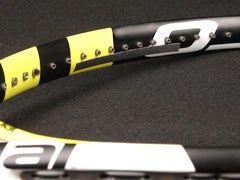
Start with about 10 grams, which will be divided into 4 strips of lead tape, weighing 2.5 grams each. If using 1/2 inch wide tape, each strip will measure 5 inches in length (1 inch = 1/2 gram). If using 1/4 inch wide lead tape, you’ll need to layer 2 of these 5 inch strips at each location, cutting the top strip slightly shorter. This allows you to more easily identify how much lead tape is on a particular racquet.
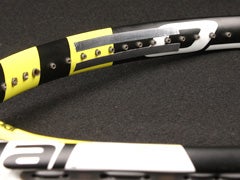
You can keep adding layers until you find the right combination of weight, balance and swingweight.
Raising a Racquet’s Sweetspot
Lead tape located at 2 and 10 o'clock
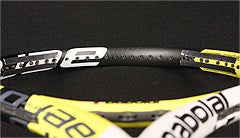
Lead tape located at 3 and 9 o'clock
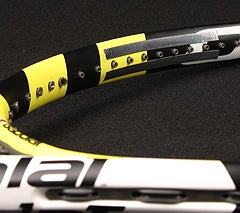
Traditionally weighted (11-12 ounces) and balanced (1/2 to 1-1/2 inches head-light) racquets have their sweetspot located in the center or lower center of the stringbed. Many players tend to hit the ball high in the stringbed, though, resulting in lackluster power and irritating frame vibration or “flutter”. Adding weight at 2 and 10 o’clock will effectively raise the racquet’s sweetspot*, making shots hit high in the stringbed feel much more solid, while at the same time increasing torsional stability (albeit, less than with weight applied at 3 and 9 o’clock). If you’re not sure where you most often contact the ball on your strings, look for a wear pattern, in the form of ball fuzz. If this still isn’t revealing enough, you can stencil your stringbed (suggested on old strings and old balls!) and then go out and hit balls. A wear pattern will quickly appear. Again, we don’t recommend adding weight in the upper hoop of lightweight, head-heavy racquets. The sweetspot on these racquets is already higher than with traditionally weighted and balanced racquets. Adding more weight in this area will only make these racquets more head-heavy and increase their swingweight, resulting in an inordinantly head-heavy, high swingweight racquet.
*A racquet’s sweetspot will move toward the area weight is being applied.
Increasing Swingweight with Minimal Added Weight
Players seeking to make a racquet swing heavier, without substantially increasing overall weight should add 5-10 grams of lead tape at the 12 o’clock position, or racquet tip.

Increasing Weight Without Changing Balance
Some players seek to simply make their racquets heavier without altering static balance. To increase overall racquet weight and retain the same balance, add weight in the throat, or 6 o’clock position. This will slightly increase swingweight, though, making the racquet a little less maneuverable.

Counter Weighting Head-Heavy Racquets
More and more players who have purchased lightweight (8-10 ounces), head-heavy racquets are experimenting with counter weighting to reduce head-heaviness and increase overall weight. Counter weighting is, as the name implies, simply adding weight to the opposite end of the racquet where most of the weight already exists. On head-heavy racquets, this means adding weight to the handle area. Again, this is a fairly straightforward procedure but does require removing the grip and butt cap. We also suggest using lead fishing weights rather than lead tape. The fishing weights come in various sizes and these weights are denser than lead tape.
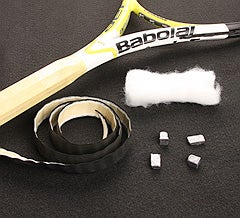
There are a few racquets that won’t allow for adding weight inside the handle, which is the procedure outlined below. They typically feature some sort of handle system for dampening frame shock & vibration. For these racquets, including Pro Kennex's Kinetic models, you’ll need to add weight by wrapping lead tape around the top of the handle.
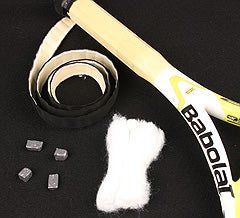
Once you’ve determined the amount of counter weight you want to apply, remove the grip and butt cap. If you are working with a polyurethane foam handle, it may be necessary to dig out some foam material to make room for the lead weights. Do this very carefully, using a long, narrow screwdriver. Hollow graphite handles won’t usually require much, if any, preparation for adding weight.
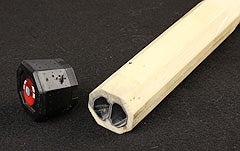
Again, racquets featuring built-in dampening systems may not allow for adding weight inside the handle. These include Head's ShockStop, Pro Kennex's Kinetic System, Prince's ShockEraser Insert, etc.
If you’re experimenting with counter-weighting, you’ll want to start with a reversible procedure that allows you to remove any added weight. This is outlined in Method 1. If you are certain of the weight you want to add in the handle, follow Method 2.
Counter-Weighting Method 1

For this procedure, you’ll need a roll of absorbent cotton, the kind used in bandaging wounds. Start by stuffing cotton down both openings and packing it in tightly until there is about 2 inches of space left. Wrap the desired amount of fishing weight(s) in enough cotton so as to keep it from rattling against the side walls and insert into the handle. It must be small enough, however, to still fit inside the opening.

Fill the remaining space with cotton, packing tightly and loosely replace the butt cap. Shake the racquet, hitting it against your hand to check for rattles. If the weights are hitting the side walls of the handle, remove and repack them in cotton and replace, being sure to fill in the top with cotton. Check again by tapping the racquet against your hand (fairly hard). If no rattles are apparent, secure the butt cap with a staple gun and rewrap the grip - see How to Wrap a Grip. Re-weigh and balance the racquet and record these numbers. Over time, the weights may work loose and start rattling, which is why we also offer a more permanent procedure.
Counter-Weighting Method 2
If you’ve already counter-weighted your racquet, using Method 1 and/or you’re certain of the amount of weight you want to add, this method bonds the weights to the handle for more permanent counter-weight. For this procedure, you’ll need a hot glue gun and/or epoxy resin.

Similar to Method 1, start by stuffing cotton down both openings and packing it in tightly until there is about 2 inches of space left. Insert a small amount of hot glue or epoxy into the handle. Place the desired amount of fishing weights inside the open handle, and surround the weights with hot glue or epoxy.

Allow to dry overnight before replacing butt cap and grip. If desired, you can add lead tape to other areas of the frame to fine-tune the racquet’s weight, balance and swingweight.
We encourage you to experiment with customizing the weight and balance of your racquet. You’ll know when you’ve found just the right formula....and so will your opponent! If you have any questions about racquet customizing, feel free to e-mail us at information.en@tenniswarehouse-europe.com.
Racquet Matching
If you are playing competitive tennis, or simply want the best performance from your racquets, racquet matching is essential. Starting with two or more like racquets, matching weight and balance will take your customization to the next level. Using the methods above, establish the weight and balance of your racquets. Record the measured specs of each racquet on a piece of paper and attach it to the racquet (either with some tape to the frame or with a rubber band around the handle). Once you have recorded the weight and balance of each racquet, there will likely be a slight difference in the measurements you have taken.
Correcting the Difference
While it is not impossible to reduce weight in a racquet, adding weight is much easier. If you have two or more racquets, making each racquet feel and play like the heaviest one is the easiest way to go.
As stated above, you can change the balance of your racquets by adding weight to various areas of the frame. If you have two racquets with the same balance, but different weights, simply add some lead tape to the throat area of the lighter racquet to bring it up to spec with the heavier racquet. Establish the amount of weight required and cut sufficient lead tape to add the required weight. Remember: 1 inch of 1/2 inch wide lead tape weighs .5 grams, while 1 inch of 1/4 inch lead tape weighs .25 grams.
If the balance points are slightly off, you will have to add weight to either the handle or the head of the lighter racquet to correct the difference. If after correcting the difference in balance, one racquet is still lighter, simply follow the directions above to add weight to the throat area of the lighter racquet.
With your racquets matched for weight and balance, treat each one to a fresh set of your favorite string and you'll be ready to hit the tournament circuit.